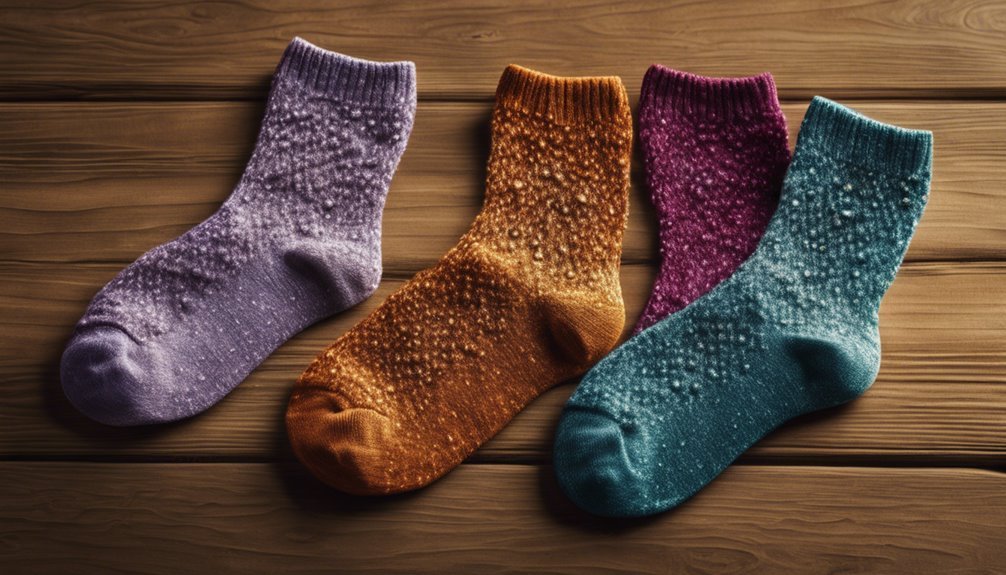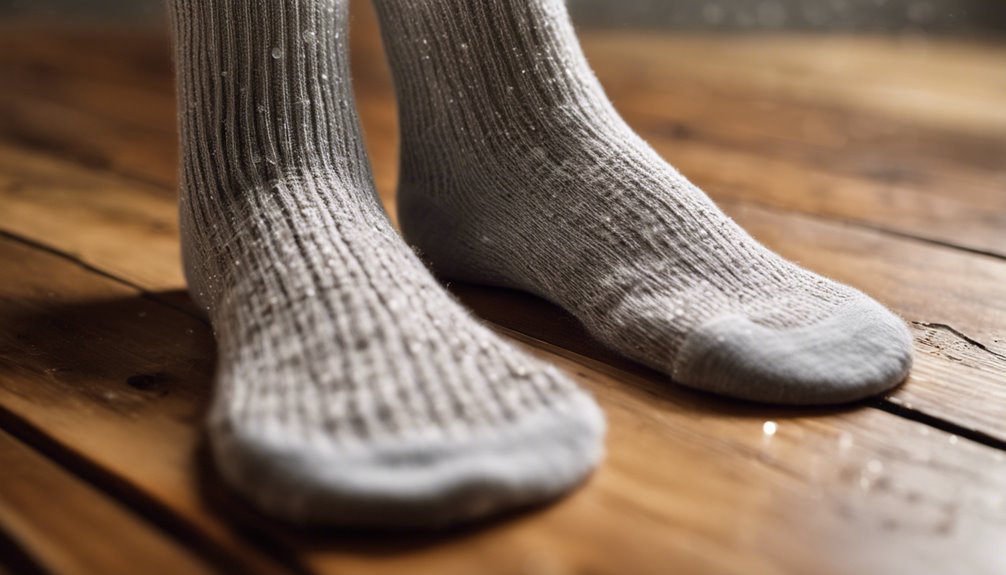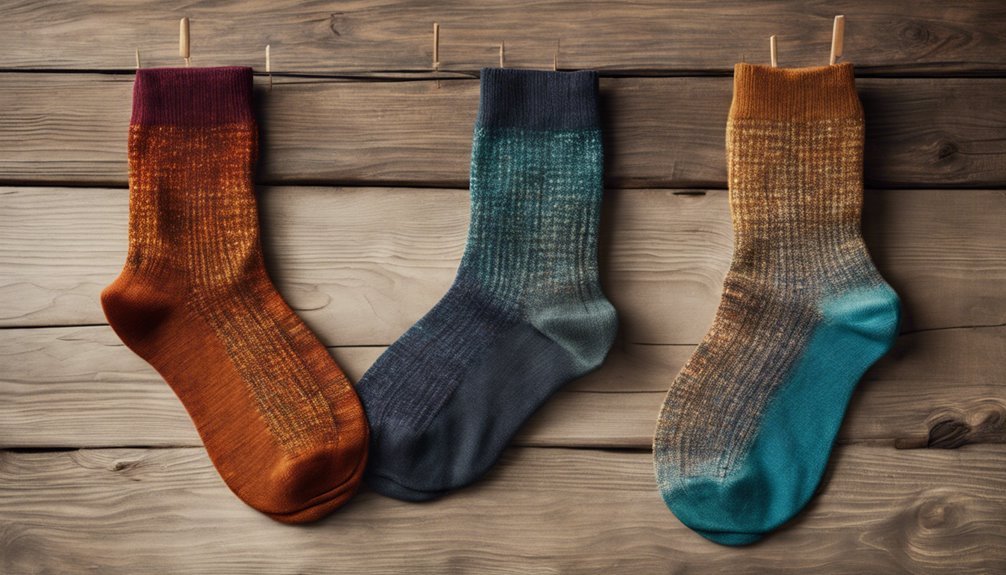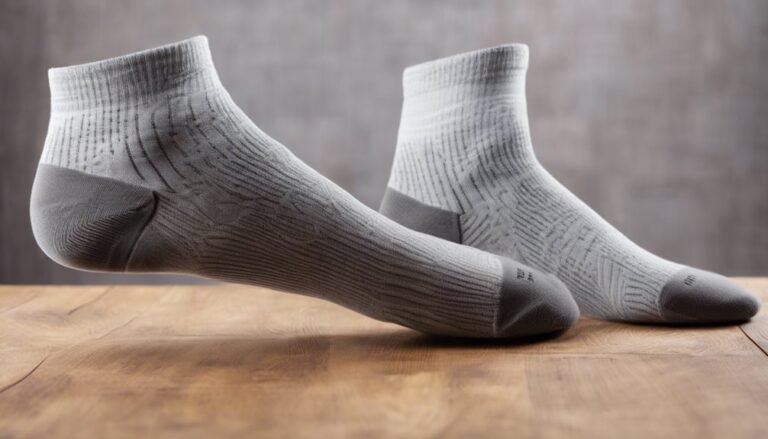Synthetic vs. Natural Fiber Socks: Which Lasts Longer?
When comparing synthetic and natural fiber socks, you'll find that synthetic options generally last longer. Their superior durability and moisture-wicking properties help resist wear and tear, keeping your feet dry and comfortable. Natural fibers, while breathable and biodegradable, tend to absorb moisture, which can lead to dampness and quicker deterioration. Ultimately, the choice depends on your needs. Keep exploring to uncover more insights that can help you make an informed decision about sock materials.
Understanding Synthetic Fiber Socks

When it comes to choosing socks, many people overlook the benefits of synthetic fiber options. Synthetic fibers, such as polyester and nylon, are engineered to enhance performance and durability in sock technology. These materials offer moisture-wicking properties that keep your feet dry, reducing the risk of blisters and discomfort during extended wear. Additionally, synthetic fibers are often more resistant to wear and tear compared to natural fibers, making them a practical choice for active individuals. Their lightweight nature also provides a snug fit without bulk, allowing for greater freedom of movement. By understanding these technical advantages, you can make a more informed decision that aligns with your lifestyle, ensuring your sock choices support your quest for comfort and performance.
Advantages of Synthetic Fibers
When considering synthetic fiber socks, you'll find that their durability and strength markedly outperform many natural options. These materials are engineered to resist wear and tear, ensuring longer-lasting performance. Additionally, their moisture-wicking properties help regulate temperature and keep your feet dry, which is vital for both comfort and foot health.
Durability and Strength
Synthetic fibers in socks offer superior durability and strength compared to their natural counterparts, making them an appealing choice for active individuals. Longevity testing has shown that synthetic fibers tend to withstand wear and tear more effectively, ensuring that your socks last longer.
Here are some advantages of synthetic fibers regarding durability:
- High fiber strength: Synthetic materials resist abrasion and stretching.
- Resistance to fading: Colors remain vibrant even after multiple washes.
- Quick-drying properties: They dry faster, reducing the risk of mildew.
- Shape retention: Synthetic fibers maintain their form over time.
- Lightweight: They provide durability without adding bulk.
Choosing synthetic socks means investing in a product that can handle your lifestyle while offering comfort and performance.
Moisture-Wicking Properties
While durability is a significant advantage of synthetic fibers, their moisture-wicking properties play an essential role in enhancing overall comfort during physical activities. Synthetic socks excel in moisture management, effectively drawing sweat away from your skin and allowing it to evaporate quickly. This rapid moisture transfer not only keeps your feet dry but also reduces the risk of blisters and discomfort, especially during prolonged wear. Additionally, synthetic materials often offer superior fabric breathability compared to natural fibers, ensuring that air can circulate freely around your feet. This combination of moisture-wicking and breathability creates an ideal environment, allowing you to focus on your activity without the distraction of soggy, uncomfortable socks. Ultimately, synthetic fibers provide an unparalleled performance advantage in moisture control.
Disadvantages of Synthetic Fibers
Although synthetic fibers offer advantages like moisture-wicking and durability, they come with notable disadvantages that can affect comfort and wearability. You might find that these drawbacks aren't worth the benefits, especially when considering environmental impact and cost considerations.
- Less breathability, leading to discomfort during extended wear
- Prone to static cling, which can be annoying
- Can trap odors more easily than natural fibers
- Often made from petroleum-based materials, raising sustainability concerns
- May have a shorter lifespan regarding comfort, despite durability
Evaluating these factors will help you decide whether synthetic socks align with your values and lifestyle or if you should explore alternatives.
Exploring Natural Fiber Socks
Natural fiber socks present a compelling alternative for those seeking comfort and functionality. Made from sustainable materials like cotton, wool, or bamboo, these socks often boast superior breathability and moisture-wicking properties. Unlike synthetic fibers, natural fibers are biodegradable, which greatly reduces their environmental impact. Studies indicate that the production of natural fibers generally consumes less energy and contributes less pollution compared to their synthetic counterparts. Moreover, natural fibers can regulate temperature effectively, offering added comfort during varying conditions. As you evaluate your sock options, consider how choosing natural fibers aligns with a commitment to sustainability and environmental responsibility. Ultimately, these choices reflect a broader desire for freedom in selecting products that are both effective and eco-conscious.
Advantages of Natural Fibers

When you choose natural fibers for your socks, you're not just opting for comfort; you're also benefiting from a range of inherent advantages that enhance performance. Natural fibers, like cotton or wool, offer unique qualities that synthetic materials often lack. Here are some key benefits:
- Sustainability benefits: Natural fibers are biodegradable, reducing environmental impact.
- Breathability features: They allow for air circulation, keeping your feet dry and comfortable.
- Moisture-wicking: Natural fibers efficiently absorb sweat, preventing odor buildup.
- Thermal regulation: They adapt to temperature changes, providing warmth in winter and coolness in summer.
- Softness and comfort: The natural texture minimizes skin irritation, leading to a pleasant wearing experience.
Embracing natural fibers means investing in both comfort and ecological responsibility.
Disadvantages of Natural Fibers
While natural fibers offer numerous advantages for sock wearers, they also come with significant drawbacks that can impact performance and durability. One major issue is moisture retention; natural fibers like cotton can absorb sweat, leading to dampness and potential discomfort. Additionally, natural fibers often suffer from reduced elasticity, which can result in sagging or losing shape over time. There are also sustainability concerns regarding the production of these materials; for instance, cotton farming can have a substantial environmental impact due to pesticide use and excessive water consumption. Ultimately, while choosing natural fibers may seem eco-friendly, it's crucial to evaluate these disadvantages when assessing longevity and performance in sock wear.
Comparing Durability: Synthetic vs. Natural
Although both synthetic and natural fibers have their unique characteristics, durability is a critical factor that often influences sock choices. When considering longevity factors, synthetic fibers typically excel in wear resistance, making them suitable for high-performance activities. In contrast, natural fibers, while comfortable, may show signs of wear faster under rigorous conditions.
Here are some key comparisons:
- Synthetic fibers often resist abrasion longer.
- Natural fibers provide breathability but may wear down quicker.
- High-performance synthetics are engineered for durability.
- Natural fibers can be less resilient to moisture.
- Synthetic options often include reinforced areas for added durability.
Ultimately, your choice should align with your specific needs and activities.
Moisture-Wicking Properties: A Key Factor

Moisture-wicking properties are essential for maintaining comfort during physical activities, especially when sweat is a factor. Synthetic fibers, like polyester and nylon, typically offer superior breathability levels compared to natural fibers, allowing moisture to evaporate quickly. This rapid moisture transfer helps regulate temperature, keeping your feet dry and comfortable, which is vital during intense workouts. Conversely, while natural fibers like cotton can absorb moisture, they often retain it, leading to discomfort and potential blisters. For long-duration activities, the ability of synthetic socks to manage moisture effectively can greatly enhance your performance and overall experience. Ultimately, choosing socks with ideal moisture-wicking capabilities can make all the difference in keeping your feet healthy and comfortable during your endeavors.
Making the Right Choice for Your Needs
When choosing between synthetic and natural fiber socks, consider factors like durability, comfort, and care requirements. Synthetic materials often excel in longevity and moisture management, while natural fibers can provide superior comfort and breathability. Evaluating your specific needs will help you make an informed decision that aligns with your activities and lifestyle.
Durability Comparison
While both synthetic and natural fiber socks offer unique benefits, their durability can greatly influence your choice depending on intended use. Synthetic fibers, such as nylon and polyester, typically resist wear and tear better than natural fibers like cotton or wool. This is largely due to their fiber composition, which allows them to withstand rigorous activities.
Consider these factors when evaluating durability:
- Resistance to abrasion: Synthetic fibers often outperform natural ones.
- Moisture management: Synthetics wick away sweat, reducing odor and degradation.
- Longevity: Generally, synthetic socks last longer under repeated use.
- Pilling: Natural fibers are more prone to pilling.
- Environmental impact: Consider the sustainability of your choice.
Ultimately, your needs will dictate the best option for you.
Comfort Factors
Choosing the right socks can greatly impact your overall comfort during various activities. When evaluating comfort levels, consider user preferences for moisture management, cushioning, and temperature regulation. Synthetic fibers typically excel in moisture-wicking, while natural fibers provide breathability. Here's a comparison to help you decide:
| Feature | Synthetic Socks | Natural Fiber Socks |
|---|---|---|
| Moisture Management | High | Moderate |
| Breathability | Moderate | High |
| Cushioning | Variable | Consistent |
| Odor Resistance | Moderate | High |
| Temperature Control | Variable | Consistent |
In essence, your choice should align with your specific activities and preferences, ensuring you stay comfortable throughout the day.
Care Requirements
Although care requirements may not be the first consideration when selecting socks, they play an essential role in maintaining the longevity and performance of both synthetic and natural fiber options. Understanding care techniques and maintenance tips can enhance your sock experience markedly.
- Wash in cold water to prevent shrinkage and color fading.
- Avoid fabric softeners, as they can degrade fibers over time.
- Air dry when possible to maintain elasticity.
- Store socks in a dry, cool place to prevent mildew.
- Rotate your sock usage to reduce wear on any single pair.
Frequently Asked Questions
Do Synthetic Socks Cause More Foot Odor Than Natural Fibers?
If you think synthetic socks can't hold a candle to natural fibers, you're mistaken. They often struggle with odor retention due to inferior moisture management, leading to a less pleasant experience during extended wear.
Are Natural Fiber Socks Eco-Friendly and Sustainable?
Natural fiber socks can be eco-friendly and sustainable, especially when made from sustainable materials. They often support eco-friendly practices, reducing environmental impact. However, it's essential to verify sourcing to guarantee true sustainability and ethical production.
Can Synthetic Socks Be Recycled After Use?
Did you know about 80% of synthetic materials end up in landfills? While synthetic socks can be challenging to recycle, some initiatives focus on synthetic recycling, promoting responsible sock disposal to reduce environmental impact and enhance sustainability.
How Do I Properly Care for Synthetic and Natural Fiber Socks?
To care for your socks, wash them in cold water using a gentle cycle. For drying methods, air-drying is best to prevent damage, while low-heat settings can be used for synthetic materials without compromising their integrity.
Are There Specific Brands Known for Durability in Each Category?
When considering durable brands, look at Smartwool for natural fibers and Darn Tough for synthetic options. These brands excel in fiber comparisons, providing evidence of longevity through rigorous testing and user feedback, ensuring reliable performance.







